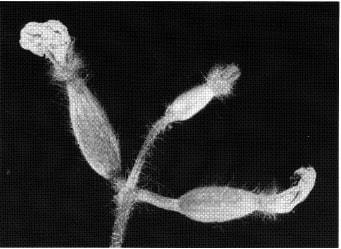Cucurbit Genetics Cooperative Report 10:45-46 (article 26) 1987
I. A. Khan, L. F. Lippert, and G. E. Jones
Department of Botany and Plant Sciences, University of California, Riverside, CA 92521
The expression of multiple flower per node has potential for concentration of fruit set with ultimate value in once-over harvest and thus reduced harvest costs. Yield potential and inheritance of multi-pistillate flowering in cucumber has been thoroughly investigated (recessive major gene, multi- pistillate, symbol mp), with the goal of circumventing “first-set fruit” inhibition (2,7). Multiple hermaphroditic flowering evident in Capsicum sp. has been transferred by interspecific hybridization with inheritance subsequently characterized as quantitative with some epistatic interactions (5,6). Muskmelon has several mutations for flower-related traits, with 13 such mutants listed in the 1986 gene list for muskmelon (1). We report here the spontaneous occurrence of multiple flowers per node.
The multiple flowering pattern was observed on a single plant of PI 414723, a monoecious introduction from India. This entry is one of several land races grown in the Indian subcontinent and locally termed “Phutt,” which means literally “to split,” referring to the extreme longitudinal splitting of fruits at maturity. We are interested in PI 414723 as a source of virus resistance. Provvidenti (4) has determined that plants within PI 414723 are immune to strains of zucchini yellow mosaic virus, and Pitrat and Lecoq (3) report it to be a source of multiple insect and disease resistance. Preliminary indications are that this material may resist egg mass survival for root knot nematodes (Mankau, personal communication).
During the process of screening shoot-tip derived plants of PI 414723 in the greenhouse for ZYMV resistance in December 1985, we observed one plant with multiple pistillate flowers at every node. The number of flowers per node varied from 2 to 5. Cuttings from the original plant maintained the multiple- flower trait. However, some branches interrupt the multiple-flowering expression with nodes of only single flowers. Cutting-derived plants were grown at 2 field locations in California in 1986. Multiple fruits were set per node and these were borne to maturity, with a noticeable concentration of set and maturity.
Reciprocal crosses have been made using both the original plant and derived cuttings with an andromonoecious commercial cv. Topmark. All Fl’s expressed monoecy, as expected, with nodes containing multiple flowers dispersed along the runners. A series of greenhouse-grown F1 plants showed multiple flowering on main runners at early nodes (5-7), at intermediate nodes (12-14), and again at later nodes (20-24). The remaining nodes either failed to form flowers or exhibited only single pistillate flowers. Individual flowers in the multiflowered nodes appeared both axially and terminally. In Fig. 1, the 3 pistillate flowers are seen terminating a lateral branch of one of the Fl’s. The central, terminal flower is the youngest, and is smaller in size and later in development compared to the 2 lateral flowers. Hybrid vigor was evident in fruit size. Additionally, some other ‘Topmark’ expression such as fruit netting and total soluble solids were strongly transmitted.
Seeds for F1, F2, and BC generations are available for field testing in 1987 to permit additional data on expression and inheritance of multiple flowering in muskmelon.
Figure 1. Multiple flowering in lateral branch F1 (PI 414723 x Topmark) muskmelon.

Literature Cited
- Cucurbit Genetics Cooperative. 1986. Gene list of muskmelon (Cucumis melo L.). Report No. 9:111-120.
- Nandgaonkar, A.K, and L.R. Baker. 1981. Inheritance of multi-pistillate flowering habit in gynoecious pickling cucumber. J. Amer. Soc. Hort. Sci. 106:755-757.
- Pitrat, M., and H. Lecoq. 1984. Inheritance of zucchini yellow mosaic virus resistance in Cucumis melo L. Euphytica 33:57-61.
- Provvidenti, R., D. Gonsalves, and H.S. Humaydan. 1984. Occurrence of zucchini yellow mosaic virus in cucurbits from Connecticut, New York, Florida, and California. Plant Disease 68:443-446.
- Subramanya, R. 1983. Transfer of genes for multiple flowers from Capsicum chinense to Capsicum annuum. HortScience 18:747-749.
- Tanksley, S.D., and J. Iglesias-Olivas. 1984. Inheritance and transfer of multiple-flower character from Capsicum chinense into Capsicum annuum. Euphytica 33:769-777.
- Uzcatequi, N.A., and L.R. Baker. 1979. Effects of multiple-pistillate flowering on yields of gynoecious pickling cucumbers. J. Amer. Soc. Hort. Sci. 104:148-151.